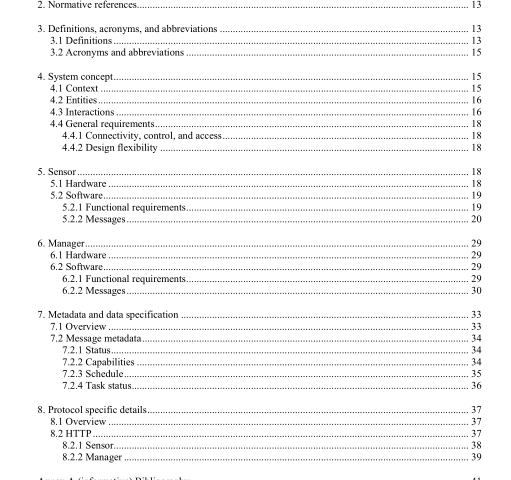IEEE 802.15.22.3-2020 pdf download.IEEE Standard for Spectrum Characterization and Occupancy Sensing
4.2 Entities
The two entities that comprise the SCOS system are the Manager (server application) and one or more Sensor(s) operating in the field. The Manager API also allows third party applications, referred to as Data Clients, to integrate with the SCOS system.
Manager: SCOS entity that allows Users and Data Clients to interact with a distributed network of Sensors via a web-based graphical user interface (GUI) and/or remotely accessible API. It exposes the capabilities of the SCOS system to Users and Data Clients, manages schedule requests by Users and Data Clients, provides control over the network of Sensors, and distributes data to Data Clients.
Sensor: SCOS entity that provides distributed RF sensing through a remotely accessible API. The API allows Manager Users to discover capabilities, schedule actions, and download data. Sensors package data with SigMF metadata (The GNU Radio Foundation, Inc) in a SigMF TAR archive (IEEE Std 1003.1-1988).
4.3 Interactions Figure 2 describes the basic interactions between a User, Data Client, Manager, and Sensor. The SCOS system supports the following interactions:
Association: Sensors may associate themselves with a Manager by sending an association request (defined in Table 1), but that does not preclude Users from registering a Sensor manually within the Manager. Similarly, a Data Client may associate itself with the Manager with a Data Client association request (defined in Table 15), but that does not preclude a User from manually registering a Data Client within the Manager. The Manager replies to an association request with an association response (defined in Table 2 and Table 16) indicating the status of the request.
Capabilities: Upon registration, or user action, the Manager may request a description of the Sensor’s capabilities (Table 5). Data Clients may also send a capabilities request to the Manager to discover a Sensor’s capabilities. A capabilities response message (Table 6) may be returned from the Sensor to the Manager and from the Manager to a Data Client.
Subscription: A Data Client may send a subscription request (defined in Table 19) to the Manager, but depending upon the implementation a User may configure a Data Client subscription within the Manager as well.
Schedule: After a Sensor has been associated with a Manager, a User may use the Manager to define a schedule request. Different implementations may choose to introduce manual approval processes, but any approval processes are implementation specific and beyond the scope of the standard. After the User specifies the schedule parameters, the Manager sends the request (defined in Table 7) to the Sensor. In response, the Sensor will notify the Manager if the schedule entry was accepted with a schedule entry response (defined in Table 8). If the Sensor accepts the schedule request, the Sensor will begin executing the action as defined in the schedule entry. Schedule entry requests may also be sent from a Data Client to a Manager.
Data Distribution: Each time the Sensor executes the action it will result in an acquisition that may contain sensed data and the Sensor sends the Manager an acquisition notification (defined in Table 13). If the Manager has Data Clients that have subscribed to receive the acquisition it will send the Data Clients an acquisition notification. In addition, the Manager may download archives from Sensors, and provide Users and Data Clients the ability to download archives.
4.4 General requirements The primary goals of the SCOS architecture are to achieve distributed persistent sensing and data aggregation. To meet these goals, SCOS developers are required to meet general requirements categorized and described in the following subclauses.
4.4.1 Connectivity, control, and access The following requirements are related to connectivity, Sensor control, and data access:
Connectivity and access: Sensors and the Manager shall be remotely accessible to authorized users over a network.
Control: SCOS entities shall provide interfaces for distributed control and data acquisition.
Discoverable capabilities: SCOS capabilities and resources shall be discoverable.
Data access: SCOS entities shall make data available to authorized users.
Data standardization: Compliance with a common metadata/data specification is required to allow for collaborative research, large-scale analytics, and sharing of sophisticated tools and methodologies. Sensor data acquisitions shall include SigMF metadata and should use the SigMF extensions defined in Annex B.IEEE 802.15.22.3 pdf download.IEEE 802.15.22.3-2020 pdf download
IEEE 802.15.22.3-2020 pdf download

Leave a Reply